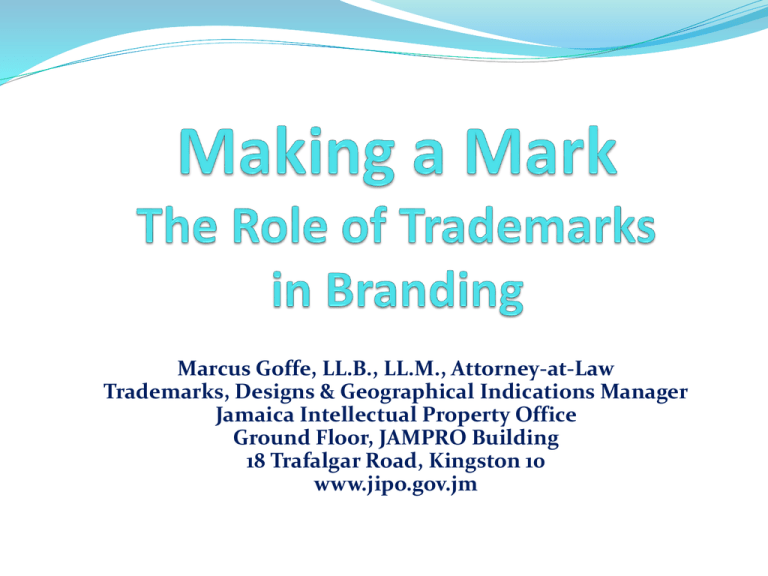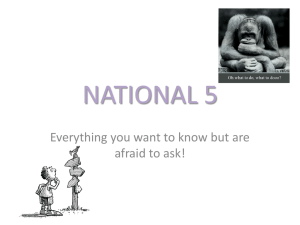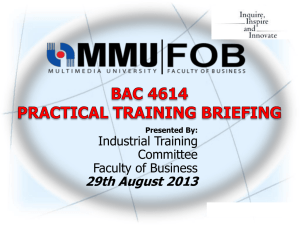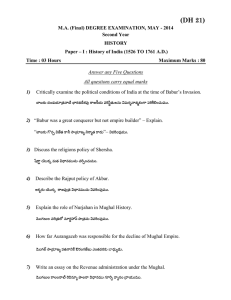The Role of Trademarks in Branding - Marcus Goffe
advertisement

Marcus Goffe, LL.B., LL.M., Attorney-at-Law Trademarks, Designs & Geographical Indications Manager Jamaica Intellectual Property Office Ground Floor, JAMPRO Building 18 Trafalgar Road, Kingston 10 www.jipo.gov.jm What is Branding? The process involved in creating a unique name and image for a product in the consumers' mind, mainly through advertising campaigns with a consistent theme. Branding aims to establish a significant and differentiated presence in the market that attracts and retains loyal customers. http://www.businessdictionary.com What is Intellectual Property? Legal rights that protect the creations of the human mind. Intangible property rights Separate property rights from the property rights of the tangible object in which the IP may be embodied or otherwise associated. Includes copyright, trade marks, designs, patents, geographical indications, plant variety protection, trade secrets/confidential information, traditional knowledge Intellectual Property INTELLECTUAL PROPERTY RIGHTS Industrial Property Trade Marks Patents Industrial Designs Geographical Indications Copyright and Related Rights Role of IP in Branding Protects creativity / invention/ investment More than one form of IP may be involved in branding Copyright Designs Patents Trade secrets/ Confidential Information Trade Marks – protect the brand/ essential to branding What is a Trade Mark? any sign that is capable of being graphically represented and capable of distinguishing the goods or services of one undertaking from those of another undertaking. “sign” includes a word, a personal name, design, letter, numeral, colour, combination of colours or a combination of the foregoing or the shape of goods or their packaging Types of Trade Marks Service marks Word marks Figurative marks Mixed marks Colour marks Collective marks Certification marks Sound marks Smell marks Collective and Certification Marks "certification mark" - a mark indicating that the goods or services in connection with which it is used are certified by the proprietor of the mark in respect of origin, material, mode of manufacture of goods or performance services, quality, accuracy or other characteristics. "collective mark'' - a mark distinguishing the goods or services of members of the association which is the proprietor of the mark from those of other undertakings. Benefits of Trade Marks Communicator to consumers Indicator of origin/source Distinguishes goods/services Indicator of quality Develop/maintain reputation/goodwill Assets in their own right Can be valued, bought, sold, licensed, willed - with or without the business Unregistered Trade Marks Protected by the common law of Passing Off No formal registration required In order to obtain redress for infringement, must prove: Goodwill Misrepresentation Damage Registered Trade Marks Protected by the Trade Marks Act Formal registration required at JIPO Registration valid for 10 years, renewable indefinitely In order to obtain redress for infringement, must prove: Use of identical or similar mark In relation to identical or similar goods or services Likelihood of confusion (unless identical) Do you Recognize these Trademarks ? Top 10 Global Brands, 2008, US$ Coca-cola $66.7 billion Toyota $34 billion IBM $59.03 billion Intel $31.2 billion Microsoft $56 billion McDonald’s $31 billion General Electric $53 Disney $29.2 billion billion Nokia $35.9 billion Google $25.5 billion Trade /Service Marks any SIGN that is capable of being GRAPHICALLY REPRESENTED and capable of DISTINGUISHING the goods or services of one undertaking from those of another Personality Rights TMs & Sports Image & Merchandising Image – includes your reputation as an outstanding athlete, as a high achiever Reputation as a good sportsman/sportswoman Personality and fame inside & outside of the sporting arena. Important for merchandising TMs & the Creative Industries Well Known personalities must also be concerned about protecting unauthorized use of their image i.e. name, pictures, photographs This includes Jamaican musicians, entertainers, artists, athletes, actors, dancers Important for the Creative Industries Non-registrability: Absolute Grounds Does not satisfy the definition of "trade mark“ Devoid of any distinctive character Consists exclusively of signs or indications which may serve in trade to designate the kind, quality, quantity, intended purpose, value, geographical origin, time of production of goods or rendering of services, or other characteristics of goods or services consists exclusively of signs or indications which have become customary in the current language or in the bona fide and established practices of the trade. EXCEPTION: Acquired distinctiveness based on use. Absolute Grounds cont’d Shape of goods Contrary to public policy or to accepted principles of morality Of such a nature as to deceive the public as to the nature, quality or geographical origin of the goods or services or otherwise Bad faith Absolute Grounds cont’d Disparages persons (living or dead) or institutions or beliefs Falsely suggests a connection with such persons, institutions or beliefs Consists of or contains a representation of the Coat of Arms of Jamaica, national flag of Jamaica and other national symbols Consists of or contains the flag of a Paris Convention country without authorization Absolute Grounds cont’d Consists of or contains the armorial bearings or other state emblems of a country which are protected under the Paris Convention Consists of or contains an official sign or hallmark adopted by a Convention country Consists of or contains armorial bearings, flags or other emblems, abbreviations and names of int’l organizations without authorization Non-registrability: Relative Grounds Identical mark for identical goods or services; OR Identical mark for similar goods or services; Similar mark for identical or similar goods or services; AND likelihood of confusion on the part of the public, including the likelihood of association with the earlier trade mark. Passing off Earlier right, in particular, copyright or design Registration Procedures Applicant’s name and address (+ for service) a statement of the goods or services in relation to which (Nice Classification) A representation of the trade mark Examination by JIPO Publication in JIPO Journal Observations Oppositions Registration Fees The Trade Mark fee is payable in two stages: i. Upon application: $7,800 (application fee include payment for the first class), plus $2,200 for every additional class. ii. Upon acceptance of the Mark for registration: $2,200.00 for advertising the Mark in the Trade Mark Journal, and a further $7,800.00 for registration. For a Certification or Collective Mark, an additional fee of $11,200.00 is required to file regulations governing the use of the Mark. Madrid Protocol Allows trade mark registration in multiple countries via one application in the home country Facilitates easier global reach of brand to the world Procedurally easier than filing several national applications worldwide Cheaper than filing several national applications worldwide Visit our Website: www.jipo.gov.jm Contact us at: Jamaica Intellectual Property Office Ground Floor, JAMPRO Building 18 Trafalgar Road Kingston 10 Telephone: 946-1300 / 946-0789 QUESTIONS?






